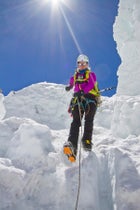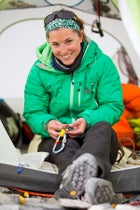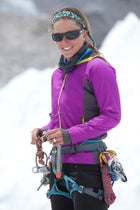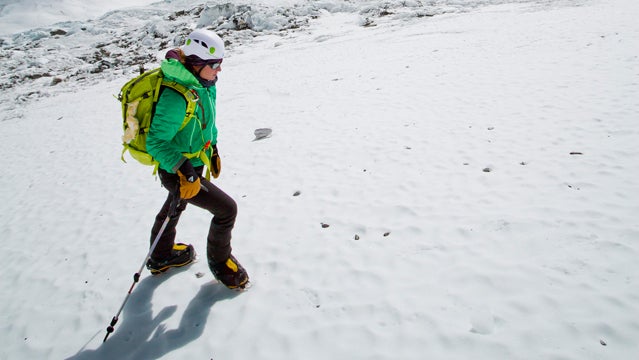I’m chasing Melissa Arnot, a female Everest guide up and down the 24 flights of stairs in the Grand America, the most posh—and palatial—hotel in Salt Lake City. We’re in town for the bi-annual Outdoor Retailer (OR) convention, the largest gathering of the outdoor industry and, outside, there’s an ice storm and the temperature is in the single digits. That’s always a little confining for the like-minded active bodies that attend this trade show, forcing us to get our workouts in where we can. In this case, it’s a set of nondescript concrete stairs with a metal railing tucked into a corner of the hotel with no windows and access through the first floor and roof only.
The �����ԹϺ���ss
Ali Carr Troxell’s column on gear for women. Melissa Arnot.
Melissa Arnot. Melissa Arnot.
Melissa Arnot. Melissa Arnot.
Melissa Arnot.Arnot, a 5’3”, petite, 29-year-old female, is shockingly pretty with honey brown hair and huge dark brown eyes. I’m also 29 and she could easily sub in as one of my best girlfriends, with whom I road cycle, hike, and backpack—she’s unassuming when you first meet her, which I find fascinating. When I met her the night before our stair climb, we were at a dinner hosted by Eddie Bauer celebrating the 50th anniversary of the first American ascent up Everest. Everyone from journalists to Eddie Bauer employees to 84-year-old Everest-climber Jim Whittaker (from the aforementioned inaugural American team) was there, so when she told me she was with Eddie Bauer, I’d assumed she was on the public relations team. I couldn’t have been more wrong.
Our sneakered feet slap the concrete steps as I chase her and try to mimic the routine she says she follows every time she’s at OR—skip steps on every other floor, sidestep facing right, sidestep facing left, and so on. She’s in training for a summer marathon and, it goes without saying, another season of climbing.
It’s kind of surprising to learn that the male, non-Sherpa record holder for summits up Everest, climbing guide Dave Hahn, has 14 summits under his belt when Arnot—the female record holder—only has four. The gap between their records begs the question: why so low, ladies? She tells me that we’re also celebrating the 25th anniversary of the first female ascent of Everest this year. Arnot says she doesn’t have an answer as to why more women aren’t climbing Everest, but that because the mountain is still in its commercial infancy—it’s only been guided for 20 years—its main pursuers are middle-age, wealthy men who want to be led by big, experienced, male guides.
Working as a woman on Everest has been a double-edged sword. Ironically, Arnot’s gender gave her the opportunity to guide there. Because she is a woman, she was able to guide on the mountain at a much younger age than any man would be able to. At 24, her inaugural season, she was a solid six to 10 years younger than all of her co-workers. Men don’t get that opportunity at that age because of the competition for the job. That said, she’s had clients refuse to let her guide them, which she chalks up to a lack of trust in her ability to guide as safely as her male counterparts. She even had a client who refused to call her anything but “hot cakes”—an experience that fuels her goal to prove that she can work as hard as any guy can.
After our grueling stair run (er, crawl), we sat down to fresh fruit and hardboiled eggs to talk about her experiences as the single female guide on Everest, her favorite gear, and what’s next for her.
What is it like to be a woman in a male-dominated scene?
When I travel and tell people I am a guide, they assume I drive a tour bus. They can’t imagine I climb mountains. But in truth, I’m not an incredible athlete with an outrageous V02 max. I’m average. I like it that they size me up and realize, well, if she can do it, maybe I can do it. And maybe they can’t, but I like that it makes them challenge themselves. I prove myself by working as hard as I can every single day and I never take the easy route—that does women a huge disservice.
What is your go-to outdoor gear?
I carry a certain kit with me no matter where I am in the world so that I am always ready to go for a hike if the opportunity comes up. The main item is my BC 200 rain shell—it’s super lightweight, small, and the most breathable I’ve ever had. It allows me to go through a lot of climate zones. Second on my list are light gloves—like Eddie Bauer’s Polartec Power Stretch gloves, which aren’t bulky but are really warm. They’re great for winter running. I always bring a light hat and my sunglasses. Smith isn’t one of my sponsors but I love them because they don’t make me look like a guide or a climber when I’m in town; I can look like a woman with at least a little sense of style.
What else?
Hydration is key. If I’m unhappy, I drink half a liter of water and everything gets a little better. So you won’t ever see me without my water bottle. One of my sponsors is —their bottle is easy to carry and spillproof so I can use it while I’m driving or running.
What other sports are you into besides mountaineering, hiking, and running?
I just started road biking and I’m really into it. And I’m bringing a lot of the same systems I use in hiking and climbing into it. The times when I am suffering indicate when I’m being inefficient. And anytime you can be really efficient, you save energy. So my system is to do whatever activity it is for one solid hour. Then I take an actual maintenance break for 15 minutes when I reapply sunscreen, go to the bathroom, eat, drink, and then I start the activity again. In climbing, I can’t drink from a hydration pack while I’m doing it because it requires my full attention. So a proper maintenance break to make sure I’m taking care of myself is key.
The sun looks brutal on Everest.
My skin is really important to me. I’m 29—I don’t want to look like I’m 49. But I spend my life in the sun. I religiously apply sunscreen every hour of every day. I have skin sensitive to fragrance so I’ve been using ’s fragrance-free SPF 30 sunscreen. I’ve spent seasons on Everest where I got sunburned the entire time but Coppertone works great for me.
You’re marathon training. What gear do you like for that?
I’ve always been opposed to boy shorts but it’s been freezing cold this winter and my butt cheeks get really cold, even under my running pants. So I go to and buy the three-pack of soft, Lycra boy shorts. They keep everything from rubbing and chafing. 2000 series has been my running shoe for 10 years. They fit my feet really well. And I’ve re-fallen in love with wool for running because of the non-stink factor and its thermoregulation abilities. I go all over the board from to to . Oh, and I love hoods.
So will we be seeing you on Everest in the spring?
Yes, but in a different capacity. I started a non-profit called the Juniper Fund with to advocate for rescue resources and life insurance for local mountain workers. As Western customers, when we hire other people for something incredibly risky, we are responsible for protecting their lives in the same say we protect our own. Sherpas are killed every year supporting Western clients and their families get a very small amount of money when that happens. As a customer, I have a responsibility to know what happens if something goes wrong before it goes wrong. So this spring I’m going to provide medical support for the Sherpas who fix the ropes before the climbers come and I’ll be traveling around Base Camp talking to customers about the insurance that’s in place for their outfitter’s staff. If clients decide to donate, the money will support families who suffer loss of life, disabling injuries, and other rescue funds.
What prompted the non-profit?
In 2010, I was climbing with a friend—he was a well-respected and sponsored Sherpa with the second-most summits under his belt, 19—and he was killed in an ice collapse. He has two sons and a wife and he was their sole supporter. For a couple of years, his wife refused to see me—she wasn’t ready. Last year, she was finally ready to see me and we sat in her teahouse but she couldn’t talk. She was just screaming and wailing. It was a grief I cannot even describe. I walked out of her house thinking that climbing isn’t worth it. I was ready to give up but then I walked a little further and thought, that’s not the right way to deal with this, there has to be a way to support this. Because the Sherpa will continue to take the work—it’s what’s available to them. They love Everest and it’s how they make their living. So I want to educate mountain users of their obligation to their support team. And help Sherpa get what they want like life insurance, grief advocacy, and social security. David and I aren’t trying to give back—we’re trying to respect our obligation as climbers.
That’s heavy stuff. What inspires you to keep climbing?
It’s important to remember that your limits are not fixed. To play in that space is a gift.


